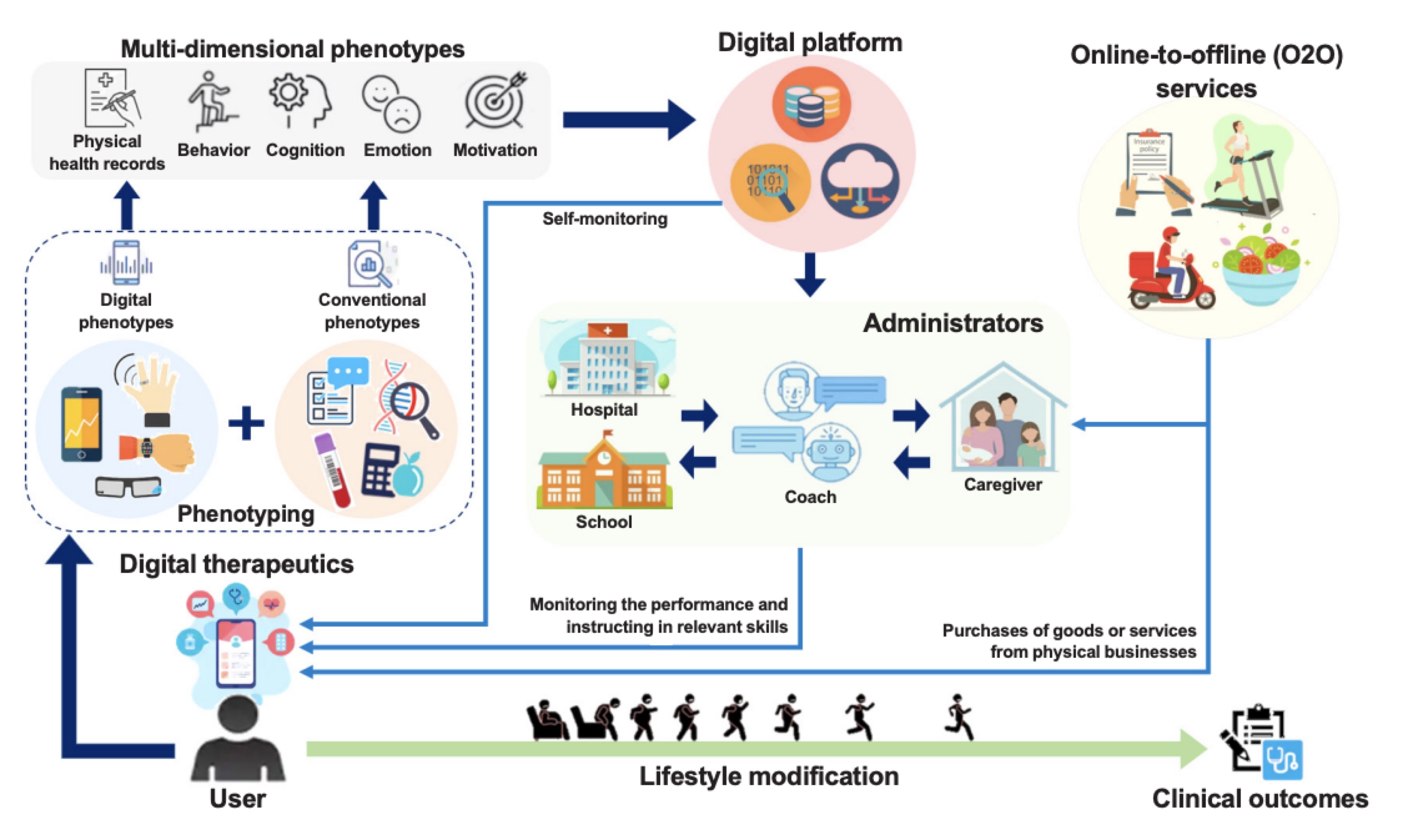Did you know that the nutrition and weight loss sector is the only segment in the wellness market maintaining positive growth despite the pandemic crisis?
As new technologies become available, trends in the digital nutrition space are rapidly changing. From personalized nutrition assessment and recommendations to AI-powered coaching and intervention design, AI significantly impacts this field. With the help of AI, digital nutrition companies can now provide customers with tailored, personalized nutrition advice, and long-term guidance and support.
In this article, we will explore the latest trends and AI solutions revolutionizing digital nutrition.
You can also read this article republished on our Medium.
What are the Trends in the Digital Nutrition Space?
The success of a product or new technology initiative is indicated by factors such as churn rate, customer retention, and lifetime value. Сustomer engagement depends on the value provided by the product, as well as its ease of use and flexibility.
Using AI and ML-powered tools at each stage of routine assessment, recommendation, and intervention design can increase the value and usability of the product.
The following are a few innovative approaches for product enhancement:
1. Multimodal Assessment & Monitoring
This approach combines digital (wearables, smartphones) and conventional monitoring methods (self-reporting, blood tests, EHR, etc.). Remote patient monitoring technology and the internet of things are making this possible, transforming the way health data is shared.
For example, Veri uses continuous glucose monitoring (CGM) combined with self-reported diet intake to generate insight into individual metabolic health for its customers. As well, Lumen measures metabolism flexibility based on CO2 levels using a proprietary device to help its customers with natural weight loss.
2. AI/ML-Powered Health Analytics
Applying AI/ML technologies makes it possible to extract clinically meaningful insights and uncover previously hidden relationships between different health predictors and health outcomes on an individual level.
This innovative approach improves data quality and management, which was an existing problem. In addition, newly-created AI models and ML algorithms improve system performance and reduce errors significantly.
Take January AI, for example. This product analyzes thousands of data points from CGM and an activity tracker (heart rate) to model the user’s physiology and predict glucose levels in real time. Other great products are InsideTracker and DayTwo.
3. Integrating DTx with Online-to-Offline Services
The interconnection of digital therapeutics and offline services allows users to access different additional services to support their health, such as healthy meal delivery(e.g., Foodsmart).

Major trends in the space include multimodal assessment and monitoring, AI/ML-powered health analytics, and DTx integration with online-to-offline services.
What are the AI/ML Emerging Tech Solutions for Nutrition & Weight Management?
Assessment: AI/ML-powered assessment and analytics for hyper-personalization.
There are a number of tools for assessment and progress monitoring that use AI/ML. Let’s see how AI/ML is used for health assessment and analytics in the list below:
1. Devices for assessment: smart scale, CGM, metabolite, & air analysis.
For example, January AI uses ML-powered algorithms to predict glucose levels just 2 hours after a meal. The system consolidates (manual) food logging, HRM data (from a smartwatch), and CGM data. When combining multiple data sources, the predictions are 31% better than the other model benchmarks.
2. Self-reporting: digital diaries and logs.
For example, Foodvisor uses self-learning algorithms to identify the type of food and each meal’s nutrient and calorie composition to help users stick to their diet and provide ongoing coaching.
3. CV: food recognition and nutrition intake tracking.
The example below is based on the CLIP architecture from OpenAI, which was trained on 400 million image-text pairs. This model allows you to not only generate pictures, but also describe what is depicted in them. As a result, this technique is quite suitable for analyzing food from images and photos, which means it should facilitate monitoring and managing personal nutrition.

4. Lab-based assessment and at-home tests: biofluid analysis and biome genetic tests.
Such companies as Vessel Health, Vivoo, DayTwo, and InsideTracker use high-precision biofluids tests and microbial diversity analysis to assess real-time body data, predict unique blood sugar responses to any food or food combination, and provide personalized nutrition guidance.
5. Time-series analysis for forecasting and trend prediction.
A 2022 study by Willem J. van den Brink used wearable technologies and remote patient monitoring (CGM and wristband) to detect active eating and predict the impact of physical activity, sleep, and dietary intake based on continuous glucose levels. The research takes the first step towards personalized, real-time lifestyle recommendations and feedback based on health monitoring data.
Recommendations: How is it possible to use AI/ML for nutrition plan recommendations?
1. Correlation network and rule-based system
The SegterraX model by InsideTracker generates ultra-personalized intervention recommendations for each individual by integrating the full range of user inputs (biochemistry, demographics, profile, habits, genetics) with rules.
2. AI-generated personalized meal plans
AI algorithms could be used to dig through multiple data sources (anthropometry, along with physical activity, dietary patterns, hunger, sleep patterns, and habits) to calculate personal calories and daily nutrient needs.
Content-based, collaborative filtering, and hybrid approaches are the standard recommended approaches. For example, DeepFM is one of the top recommendation algorithms today, combining the power of factorization machines for deep learning and feature learning in a new neural network architecture.
3. ML-based nutrition plan readjustment in real-time
Based on personal metabolism and biodata tracking, ML algorithms could be used to facilitate smooth weight loss and ensure that the user stays on track. These algorithms constantly assess the personal data trends (remote patient monitoring and self-reported) and make informed changes targeting the client’s fitness through the nutrients supplied.
For example, a significant step forward in the recommendation algorithm is a combination of batch training with online training, which allows for real-time adaptation.
This is how top recommendations work on TikTok, Instagram, YouTube shorts, etc. According to some developers, using DeepFM and online learning could improve the conversion rate by 30%, merchandise value by 30%, and engagement time by 50%.
Interventions: Could AI/ML help you build a healthy daily eating routine?
AI could recommend specific dishes, ingredients, and recipes based on a meal plan, available ingredients, and the user’s fridge. Similar algorithms could also be used to create a daily meal plan or a shopping list based on calculated calories and nutrients, personal preferences, and household size.
1. Optimization algorithms such as mixed-integer nonlinear programming (MINLP).
These are perfect for problems with nonlinearities in the objective and/or constraints, as well as continuous and integer variables.
2. Genetic algorithms (GA) as a more generic approach for optimization problems.
Here is a list of potential use cases to consider:
- Create a shopping list based on the meal plan
- Make a meal plan based on the products you have
- Create a shopping cart and place an order (for example, see Foodsmart)
- Replace or skip dishes you don’t like
Implementing Nutrition & Weight Management Solutions with AWS
As an AWS Advanced Tier Services Partner and AWS Well-Architected Partner, Neurons Lab specializes in designing and deploying cutting-edge AI-driven digital nutrition and weight management solutions by leveraging the power and flexibility of the AWS Reference Architecture. By harnessing a range of AWS services, we help businesses build, deploy, and scale innovative AI/ML applications that revolutionize the nutrition and weight management industry.
To build a tailored AWS solution for digital nutrition and weight management, Neurons Lab recommends utilizing Amazon SageMaker for model development, training, and deployment. Amazon SageMaker is a fully managed service that simplifies the entire machine learning process, allowing developers to experiment with various algorithms and ML frameworks. By automating model selection, Amazon SageMaker ensures the most optimal models are chosen for specific use cases, such as personalized diet recommendations and health analytics.

For processing large datasets, which are crucial for accurate and personalized nutrition and weight management solutions, we propose integrating AWS Glue, a serverless data integration service, and Amazon Redshift, a fast, fully managed cloud data warehouse. AWS Glue helps manage and process vast amounts of data, while Amazon Redshift enables efficient storage and analysis of data, allowing for the development of powerful AI/ML-driven applications.
As an AWS Well-Architected Partner, Neurons Lab follows the best practices outlined in the AWS Well-Architected Framework when designing and deploying solutions in the cloud. This framework provides guidelines for creating scalable, efficient, and secure applications capable of handling the massive data generated by AI/ML-driven nutrition and weight management solutions. Our adherence to these best practices ensures the delivery of transformative, personalized nutrition advice and long-term guidance to users worldwide.
To facilitate data visualization and business intelligence, we recommend using Amazon QuickSight, a scalable, serverless, and embeddable analytics service. With QuickSight, businesses can create interactive dashboards and reports, empowering stakeholders to make data-driven decisions and track the performance of their AI/ML-driven nutrition and weight management solutions.
By combining the expertise of Neurons Lab with the power of AI/ML technologies and the flexibility and scalability of AWS, we can help businesses in the nutrition and weight management industry transform their digital offerings and deliver superior personalized experiences to their customers.







